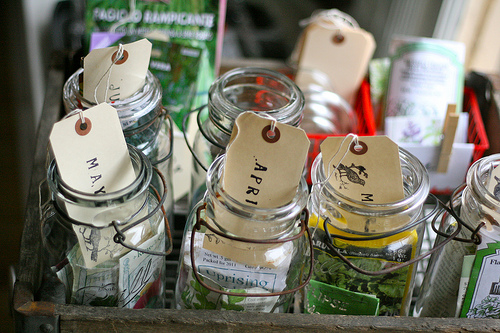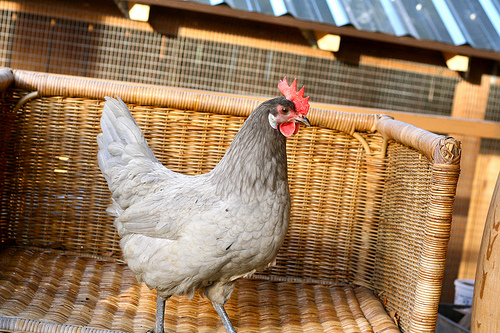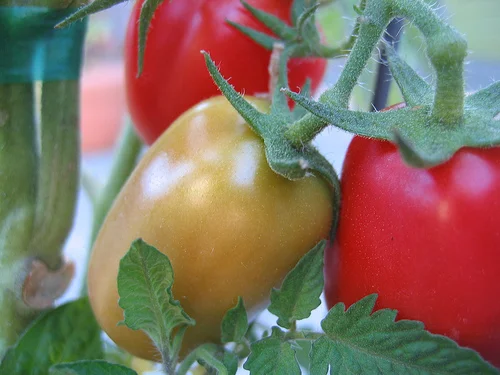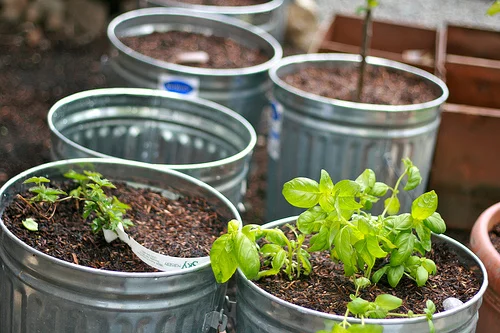urban farm update: february 2012
And by early spring I mean 'wishful thinking.' As in: it is all I can do to wait until the 'dirt is warm' for planting. Here in the Pacific Northwest, the soil isn't warm to the touch until June (though at least my garlic is appearing---see pic above). I ogle my jars with seeds, but refrain from rushing outside to plant my corn and beets, tomatoes and pole beans. Instead, I am planning garden beds and rotation(s), using our dining room window seat as a stand-in greenhouse and waiting for little green tips to appear in dirt-lined egg cartons.
I started collecting egg cartons to start seeds, and am hanging onto yogurt containers, and plastic spinach and salad containers for growing plants indoors. I love the idea of re-purposing any and all containers for my garden-in-the-making. Inside, I have cauliflower peeking out of the soil (pictured above), San Marzano tomatoes planted (seedling below) and just today I added cartons of lavender, parsley and 'Florence' tomatoes.
This year that I intend to wrap my mind around: year round planting. In my humble and not so distant gardening past, I planted in June, harvested in August and waited for everything to die. Although I have so much to learn, I now appreciate that my garden is much more than a 3-5 month summery window. Instead, a garden can be productive year round---and I intend to wield my hoe/shovel/rake and shears accordingly.
We have a number of raised beds, both in front of our home and along one side. I have ample space partitioned for tomatoes and corn, will add a few espaliered trees (we have one young apple tree so far---I plan to add fig and pear trees) and beds of lavender.
Here is what I have done so far: dug up my beds, shoving dead leaves and new compost into existing beds. (This year I had to use purchased compost, but am hoping to have my own compost pile soon). Besides readying the dirt, I planted some seeds that are good to go 'as soon as the soil can be worked.' So what if I took a pickaxe to the soil and wore mittens? That soil was unequivocally workable when I was through with it. I planted spinach and lettuce seeds, leeks and sweet peas, carrots, parsnips and nasturtiums and potatoes. I also transplanted blueberry and rhubarb starts.
I am not usually patient enough for 'successive planting' but am determined to fold that concept into my farmer mentality. For example: I planted carrots. It is recommended you plant them every few weeks---so you can enjoy a continued harvest---instead of just one bumper crop. I planted the carrots in February, then stuck the seed packet into my 'March' jar (see picture of 'monthly jars'). This should keep me on track.
Sowing and tilling aside. We have work to do on the farm that goes beyond mere crops. We have gravel to lay and decks to build, side yards to organize and a backyard that remains a pile of dirt. Truth be told, we love the process: planning, gathering ideas, aiming to be spend-thrift and recycle materials as much as possible.
My most recent 'savings' was in the form of a trellis. I found old, dried stalks of fennel---sturdy, forgotten and a nice gray hue---and gathered them to make trellises (my son Caleb helped me, see pic below). I used old garden tools (some that were left on the property when we bought it, and others I have picked up at garage sales) like rusty hoes, rakes and shovels, and constructed a makeshift trellis. Now my sweet peas and pole beans have a lovely place to climb. Other ideas for trellis-making: wooden ladders, old pipes from plumbing, small tree branches and forgotten fences.
It wouldn't be a farm update without mentioning our 'girls.' The chickens are doing fabulously. They love their coop, lay frequently (our average is 6 eggs a day) and love a daily tromp around our yard. We let them out of the coop---supervised---for about an hour a day. They nibble the grass, find worms and bugs and take a communal dirt bath (which I liken to a 'spa day'). When it is time for them to return to their enclosure, I shake the dried meal-worm container---and they come running for their favorite treat.
Pictured above: 'Megs' (short for nutmeg) is a copper-laced wyandote. She is friendly and quiet, lower in the pecking order but a good sport about it. She is friends with Fleur, a high-strung white-laying chicken pictured above Megs. 'Fleur' is short for fleur de sale--a french sea salt with the same hue as our sassy girl. Then there is Brandy, below. Top of the pecking order, a good supervisor, she is sitting in the 'spa.' We have a total of 8 lovely chickens; read more about their coop and/or personalities.




















